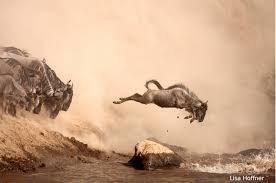StonesWild 9/30/15
First off let me thank you all for reading this- Its important my blogs get recognized properly
Article twelve, here we go.
I, Stone, would like to welcome you all to todays wildlife discussion...

Article twelve, here we go.
I, Stone, would like to welcome you all to todays wildlife discussion...
Every year, the wet and dry seasons of Africa bring worldly change to the grasslands of the Masai Mara in Kenya. Although these quickly surging changes take effect in only days, turn scrubland to swamp in a fortnight, seemingly unique to this area of the Dark Continent...the ecosystem's philosophy here is the same as anywhere else where the rules of the wild still preside over the lives of the inhabitants...only the most adaptable survive.
The largest herds that participate in this mad rush are composed of White Bearded Wildebeest, Thomson's Gazelles, and Burchell's Zebra. The greatest component, however, are the wildebeest. This is due to the wildebeest's requirements for phosphorus, which cannot be found in enough quantity annually in their favored habitat to sustain them.
The enormous influx of ungulates through such a relatively small corridor of land gives one almost certainty that every East African predator would make a point not to miss this opportunistic repast. Consequently, Nile Crocodiles, Lions, Spotted Hyenas, and several vulture species often trail the migrants, with the chief exception of the crocodiles, who prefer to lie in wait at river crossings. It's been estimated that roughly 3,000 Lions and 9,000 Spotted Hyenas share the plains of the Masai Mara with the migratory animals.
The fault of the nomadic predators, however, is that of their placement- the very plains the ungulates make leave from when the rains fail are the greatest kingdom for these carnivora. It seems that the majority of their population is left behind as the migrant herbivores set out for pastures new. Therefore, in addition to arriving where the vital nutrient phosphorus can be found, the predators are temporarily outrun.
Thank you everyone for reading! I hope you all enjoyed it.
All the Best,
Safari Stone
No comments:
Post a Comment